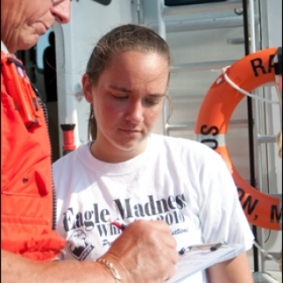Eight students will be presenting the summer work at the Ocean Sciences Meeting in March 2022!
Kelly Rooker, Bridgewater College
Class Year:
2010Mentor:
Lora Harris, Ph.D.Project Title:
The Modeling and Evaluation of Wild Rice Zizania aquatica Particle Capture at Jug Bay, Maryland
Abstract:
Freshwater tidal marshes are important ecosystems located between fresh and oligohaline waters. These ecosystems are constantly undergoing sediment changes, with sediment simultaneously being deposited, carried away, and/or captured by the vegetation present. In a wild rice-dominated part of the low marsh at the Jug Bay Wetlands Sanctuary in Maryland, we observed sediment dynamics over a tidal cycle with an emphasis on looking at particle capture by groups of wild rice. We then used much of this data to build a model for particle capture in a tidal freshwater wetland. A sensitivity analysis was done using this model, and the model was also parameterized with data from the Jug Bay/wild rice field work. In addition to concluding that morphology does affect sediment capture rates and that spatterdock have higher sediment capture rates than wild rice, we also concluded that the amount of particles captured per stem is most dependent upon water velocity, total suspended solids (TSS), and the percent particles captured.
Location:
Chesapeake Biological LaboratoryPresentations:
Rooker, K.*, and L. Harris. 2011. The modeling and evaluation of wild rice Zizania aquatica particle capture at Jug Bay, Maryland . ASLO Aquatic Sciences Meeting, San Juan, PR .





